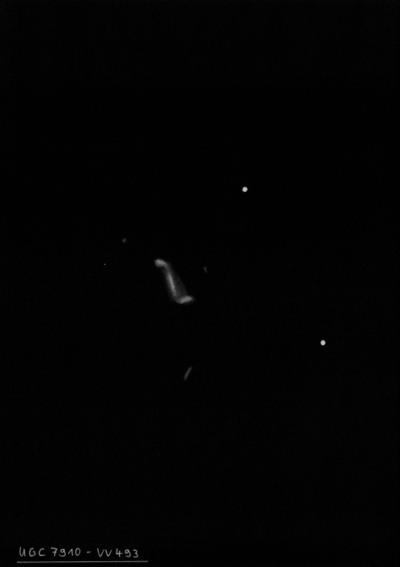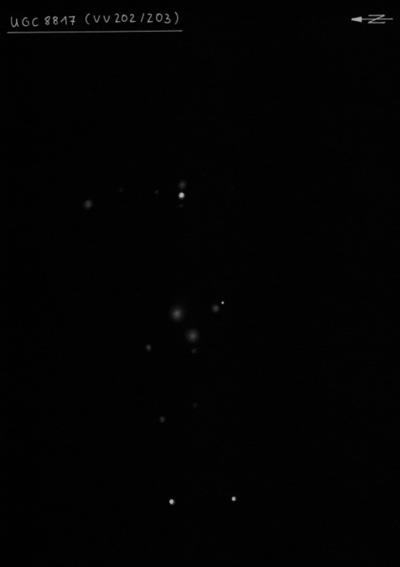A small constellation of the northern sky in a relatively barren region below the rim of the Big Dipper, between the Boötes and the constellation Berenice's Hair. It is partly circumpolar in our latitudes, being highest in the sky during the lengthening evenings of the spring season. The Hunting Dogs are located near the galactic pole, so we see this constellation perpendicular to the Milky Way from us and therefore see far beyond our Galaxy. It should come as no surprise that the Hunting Dogs are very rich in extragalactic objects. Virtually all of the galaxies in the constellation visible in our amateur telescopes are part of one massive supercluster of galaxies, Virgo, the center of which is 60 million light-years away from us and is projected in the sky at the boundary between the constellations Virgo and Berenice's Hair. Our Local Group, which lies on the edge of this supercluster, is probably part of it. There are three groups of galaxies in the Hunting Dogs. The closest, about 20 million light-years away, is the Canes Venatici I group, which includes galaxies such as M94, M106, NGC 4214, NGC 4244, NGC 4395, and NGC 4449. Another group, Canes Venatici II, 35-40 million light-years away, includes M63, NGC 4111, NGC 4242, NGC 4490, NGC 4618, NGC 4631, and NGC 4800. The third group, Ursa Major I, 70-80 million years away, includes NGC 4145, NGC 4151, NGC 4217, and NGC 4369.
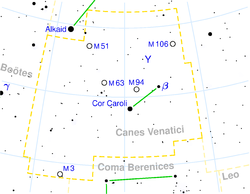
Cor Caroli (α CVn) - "Karlovo srdce", the brightest star of the constellation. This star was named by Edmund Halley on the suggestion of Sir Charles Scarborough, the court physician and physicist, who claimed that the star shone exceptionally brightly on May 29, 1660, when the English king Charles II, the founder of the Greenwich Observatory, returned to London. Another story says that it is the heart of King Charles I, executed on the orders of Oliver Cromwell in the mid-17th century, which made its way to the sky.
Y CVn (E-B 364) - "The Superba," that's how Italian astronomer Angelo Secchi named this significantly red star in the 19th century. It is a variable star that changes its brightness from 4.8mag to 6.4mag in a period of 157 days. The striking red hue can be easily seen in 50-60 mm telescopes. The unusual, dark red color of this and similar stars is a result of the presence of carbon molecules (which are abundantly present in the atmosphere) absorbing the blue light of the star.
25 Canum Venaticorum - A binary star that splits into two yellow components of brightness 5mag and 6.9mag in a 15 cm telescope. Their angular separation is 1.8".
M 51
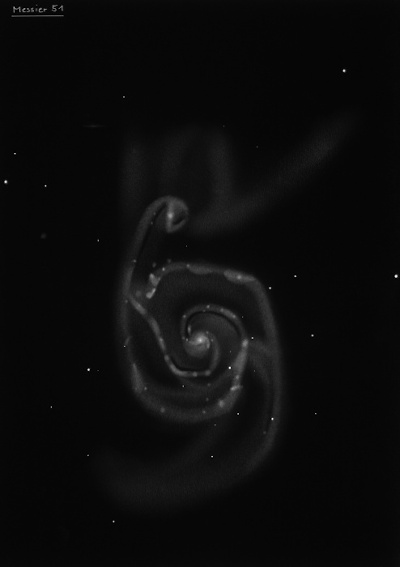
Charles Messier discovered M51 = NGC 5194 = h1622 on 13 Oct 1773 with a 3.5-inch refractor. Johann Bode made an independent discovery on 5 Jan 1774, along with the first drawing using his 3-inch refractor. Using his 12-inch (20-ft focal length) on 20 Sep 1783, William Herschel commented (clearly interested if it was a cluster), "most difficult to resolve; yet I no longer doubt. In the southern nebula I saw several stars by various glimpses, in the northern also 3 or 4 in the thickest part of it, but never very distinctly." Viewing with his 18.7-inch on 29 Apr 1788, he described "Two, the most south vB, L, surrounded with a beautiful glory of milky nebulosity with here and there small interruptions that seemed to show the glory at a distance." On 12 May 1787 he recorded "B, a very uncommon object. Nebulosity in the center, with a nucleus surrounded by detached nebulosity in the form of a circle; of unequal brightness in 3 or 4 places; forming altogether a most curious object." He apparently never observed M51 with his 48-inch reflector (40-foot focal length). John Herschel described M51 as "A very bright round nucleus surrounded at a distance by a nebulous ring" and as a "double ring, or rather one-and-half rings rather like an armillary sphere."
M51 was the first galaxy in which spiral structure was clearly seen. The discovery was made by Lord Rosse (William Parsons) using his newly completed 72-inch Leviathan in the spring of 1845 (replacing the earlier 36-inch scope). No observing logs were kept of the earliest observations, so the exact date in unknown, but spirality was not reported by Romney Robinson (director of the Armagh Observatory) and James South (double star observer) during their observation on 5-6 March 1845, which focused on resolvability. In early April 1845 (possibly the 6th), William Parsons observed alone and "discovered" the spiral structure, producing a stunning sketch that was circulated at the British Association for the Advancement of Science in Cambridge in June 1845. By 1850, M51 had been observed at least 28 times and a second, more dynamic sketch implying motion, was published in LdR's 1850 "Observations of the Nebulae" (plate XXXV, figure 1).
Probably using LdR's drawing as a "guide", William Lassell sketched the spiral structure and connecting arm on 12 May 1846 (in his notebook) with his 24" equatorially mounted reflector. He made two detailed sketches using his 48" in 1862 from Malta, showing slightly variations in the spiral structure. Jean Chacornac made an excellent pencil sketch (unpublished) in 1862 using the 31" silvered-glass reflector of the Paris Observatory. Using only a 9.6" refractor at Rome, Father Angelo Secchi claimed "even in our telescope it is easy to recognize the spiral and the two branches can be followed very well." (he often compared his telescopic views favorably with LdR's and Lassell's).
A bitter debate between Wilhelm Tempel and Dreyer began in 1878 after Tempel was highly critical of Lord Rosse's and William Lassell's sketches of spiral structure. Tempel had only observed M51 through the 11" refractor at Arcetri, and although he sketched curving arcs in the halo, he felt Rosse and others were interpretating these features as spiral forms. He wrote "one cannot fend off the thought that these forms and shapes are only figments of the imagination...". On 29 Apr 1889 Isaac Roberts obtained the first photograph of M51, ending the debate.
As far as the origin of the nickname "Whirlpool Galaxy", Ormsby Mitchel's Sidereal Messenger column in November 1847 (Vol. 2, No. 4) announced "Lord Rosse's Whirlpool Nebula" and included a copy of his sketch. The following year Romney Robinson described spiral nebulae "... resemblance to bodies floating on a whirlpool is, of course, likely to set imagination at work..."
200/250mm - 8" bright, large, hint of spiral arms.
300/350mm - 13.1" (4/24/82): very bright, very large, bright nucleus. Two winding spiral arms are obvious with a dark gap between the arms on the west side. The connecting arm to NGC 5195 is definite although near my visual threshold. There is a sharp bend in the outer arm at the south end of the galaxy. After this point, the arm trails faintly north to NGC 5195 located 4.6' from center.
400/500mm - 17.5" (3/28/87): stunning spiral structure, connecting arm visible with direct vision. First observation with 17.5" on 23 Mar 1985.
900/1200mm - 48" (5/12/12, 4/7/13, 4/30/19, 5/3/19): during these observations through Lowrey's 48" I focused on some of the stellar clusters and brighter knots in the spiral arms, which have a very high contrast with the large, dusty, darker regions between the arms. The "southern" arm nearly merges with the core on the northeast side. Two clusters and a cluster/HII region were seen as faint "stars" very close east and northeast of the core. [BGG2008] A1 is a mag 17.5 "star" 30" NE of center and similar [BGG2008] 3cl-b is 30" E of center. The designations are from a 2008 study by Bastian et al. A stellar HII region ([CCM69] 37A) is only 10" NE of 3cl-b.
As this arm unwinds clockwise to the west, two close very small, fairly bright knots ([CCM69] #77 in Carranza, Crilon and Monnet's "Kinematic Study of Ionized Hydrogen in M51" in A&A, 1, 479) are visible 1.6' W of center, just SE of a star. A small bright knot (#71) is further out on this arm, 2.3' SW of center. The section of the arm between these knots is quite bright and mottled. The southern arm then continues to swing around on the east side and heads north, with a lower surface brightness bridge to NGC 5195.
The "northern" arm begins on the south or southwest side of the core, and a series of small knots (#60/67) are along the inner south side, roughly 1' from center. As the arm unwinds on the east side of the core, a large bright knot (#52) resides ~1.4' ESE of center. The arm is quite bright in a large, clumpy region (#27/29) as it heads north in the direction of NGC 5195. At the closest point to NGC 5195 are 4 very small knots; the brightest is #10, 2.6' NNE of center. Very close southwest is #8 and just northwest is #5. This arm has a sharp bend and shoots west on the north side and includes a moderately large, brighter patch (#90/91) 2' NNW of center. The arm fades somewhat as it unwinds further along the western edge of the halo.
48" (4/2/11): during this observation I focused on the attached companion NGC 5195. The entire connecting arm was always a prominent direct vision feature of the pair with variations in brightness and width along its length. The arm brightened as it connected to NGC 5195. The slightly oval core was extremely bright but nevertheless a very bright stellar nucleus punctuated the center. The spiral arms had an extremely high contrast and appeared etched in the eyepiece like a photograph with a great deal of knotty structure. The outer arm that sweeps clockwise to the north and then around the west side extended much further south (~5' from center) than I had ever previously seen and separated quite a bit from the main spiral. Sprays of nebulosity looped off of NGC 5195 to the north (see notes).
Notes by Steve Gottlieb
M 3
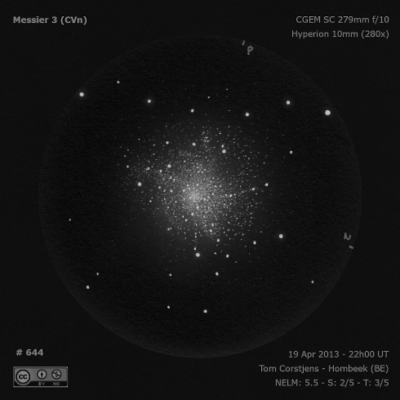
Charles Messier discovered M3 = NGC 5272 = h1663 on 3 May 1764. William Herschel, observing in 1799 with his 10-foot telescope [8" aperture] at 120x, noted "with an aperture of 4 inches it is resolvable; with 5 easily resolvable; with 6 it is resolvable; with 7 and all open the stars may be easily perceived." JH recorded (sweep 417) "A most superb object, diam = 10s time in RA. Not less than 1000 stars 11m and under. They run into a blaze at the centre, and form as it were radiating lines and pointed projections from the mass, with many stragglers."
Several observation at Birr Castle noted dark lanes or dark notes in the cluster. On 16 Feb 1869, C.E. Burton recorded "Radiating branches somewhat resembling a St. Andrew's cross, central mass globular. There seemed to be a bifurcated dark lane in the north segment of the nucleus." On 21 Apr 1873, Ralph Copeland noted "Several small dark holes on the nf side of the central mass."
200/250mm - 8" (5/26/84): the outer halo well resolved into several lanes converging to an intense core. A few faint stars are resolved on the edge of the core.
300/350mm - 13.1" (5/26/84): stunning, several hundred stars resolved at 220x including the dense core.
900/1200mm - 48" (4/19/17): at 375x the 16' field was plastered with an uncountable number of stars. I noticed the brightest star in the core had an orange hue.
Notes by Steve Gottlieb
M 94
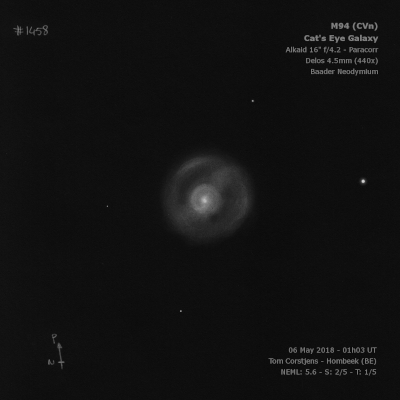
Pierre Méchain discovered M94 = NGC 4736 = h1456 on 22 Mar 1781. William Herschel recorded (sweep 717 on 18 Mar 1787) "very brilliant. A large, luminous nucleus of more than 20" diameter with faint chevulure and branches extending 6 or 8'." Again on 9 Apr 1787 (sweep 725), he logged "Very brilliant, with much F nebulosity on the sp and more on the following side." JH published 6 observations and noted on sweep 150 "vB; R; psvmbM to a nipple; with 240, r; glimpses of stars seen. A fine object. 90" or 2' in diam."
Bindon Stoney reported it as a new spiral in his observation at Birr Castle on 9 Apr 1852. On 13 Apr 1855, R.J. Mitchell logged "vlE pf, dark ring round the nucleus, the bright ring exterior to this. The annulus, however, is not perfect, but broken up and patchy, and the object will probably run out to be a spiral.
300/350mm - 13.1" (4/12/86): very bright, very impressive, fairly large, oval WNW-ESE, very bright core containing a stellar nucleus.
Notes by Steve Gottlieb
M 106
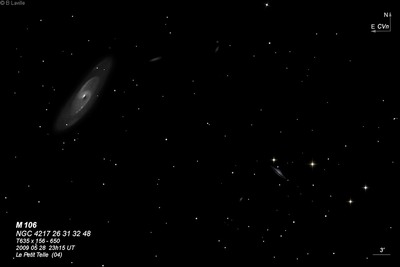
Pierre Méchain discovered M106 = NGC 4258 = H V-43 = h1175 in July 1781. It was discovered after Messier's final catalogue was sent to publication but was included in a letter dated 6 May 1783 to Johann Bernoulli, the editor of the Berliner Astronomisches Jahrbuch and published in the 1786 Jarbuch volume. Méchain wrote, "In July 1781, I have found another one close to Ursa Major near the star No. 3 of Canes Venatici & 1 deg more or less to the south; I estimate its right ascension 181d 40' & its declination about 49d."
William Herschel independently discovered this galaxy on 9 Mar 1788 and recorded H. V 43 as "v brilliant. BN with much fainter branches from np to sf, about 15' long, and the sf running out into vF nebulosity extending a great way." On 1 Apr 1788 (sweep 823) he logged "vB, mE directly in the meridian [N-S] with faint branches 10 or 12' long, BNM with the nucleus not ground."
John Herschel made 4 observations and recorded (sweep 330) "vB; vL; vsvmbM to an oval nucl; 8 or 9' long; 4 or 5' broad." The 20 Apr 1857 observation at Birr Castle (by R.J. Mitchell) reads "a vL, B, E neb np sf, much mottled. The f edge is comparatively sharp and well defined, but in the p and n edge there is a great inequality of light. Nucleus elongated, vB part to north of nucleus."
200/250mm - 8" bright, very large, elongated, bright core.
300/350mm - 13.1" (4/12/86): bright, very large, bright core, substellar nucleus, mottling near core. A large bright knot is at end of the southern arm.
13.1" (3/17/86): very bright, very large, impressive! Contains a nearly stellar core in a high surface brightness oval disk.
400/500mm - 17.5" (4/7/89): very bright, very large, very elongated 3:1 NNW-SSE, 14'x4', large bright core concentrated to a very small brighter central region. A thin bright spiral arm attached at the core extends towards the NNW on the following side of the galaxy. There is a sharp edge along the west side of this arm.
Notes by Steve Gottlieb
NGC 4631
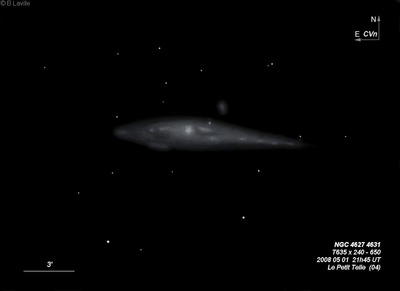
William Herschel discovered NGC 4631 = H V-42 = h1397 on 20 Mar 1787 (sweep 722) and recorded "vB, mE from sp to nf, but near the parallel. About 16' long and mbM. A little below the center of it is a small star, but probably unconnected." John Herschel made two observations and called it (sweep 74) "vmE; a long ray which crosses the whole field, rather curved upwards (to south). Has a vF nucleus and a B * nearly in the parallel." His sketch of the pair is on plate XV, figure 76 of the Slough Observations.
Three observations were made at Birr Castle. On 26 Mar 1848, William Rambaut (Lord Rosse's assistant), wrote, "A most extraordinary object with a B * near the centre, and at the right [north] masses of light appear through it in knots." George Johnstone Stoney made a detailed sketch on 19 Apr 1849 (published in the 1850 PT paper). William Lassell sketched the galaxy on 27 May 1862 from Malta (plate V, figure 24) and included a knot on the west side, the bright region east of center, and a third knot towards the east end. To determine a position, Kobold measured two of the knots/star clouds - one on the west side (#63/64) and the bright region east of the geometric center (#33-36).
300/350mm - 13.1" (5/26/84): stunning galaxy, very bright, unusually large and interesting edge-on E-W, 15'x1.5'. A bright knot is east of the core and a faint knot is west of core. Appears very mottled along the major axis. A mag 13 star is just north of the core. NGC 4627, a companion galaxy, lies 2.6' NW of the center.
400/500mm - 17.5" (6/5/99): at 280x (14' field) this remarkable galaxy runs edge to edge across the field! The surface brightness is unusually irregular with bright and dark mottling across the surface. There is no well-defined core but a prominent knot is close following (east) the geometric center along the north side and a second weaker knot is along the west side. The north edge has an unusually "scalloped" appearance particularly along the west side due to dust and brighter splotches. The galaxy gradually bulges towards the center and tapers at the tips, particularly along the west end. A mag 13 star is situated just north of the edge at the geometric center and NGC 4627 appears to hover over this "starship" a couple of arc miinutes northwest of center.
900/1200mm - 48" (4/16/15): Although I've viewed NGC 4631 a few times previously in the 48-inch, it was difficult to take notes as the amount of structure was overwhelming. At 375x (13mm Ethos, 16' field), the galaxy stretched across nearly the entire field and consisted of numerous bright luminous patches and irregular dark patches. The overall shape is asymmetric; gradually tapering down to nearly a point on the west end, bulging in the center and broader along the eastern side, only narrowing significantly near the very tip.
A mag 13.5-14 star is just north of the western tip. A relatively bright knot (NGC 4631:[HK83]#91-94, from Hodge and Kennicutt's 1983 "An Atlas of H II regions in 125 galaxies") lies 0.6' SE of this star and 5.8' W of center. Several obvious bright knots and splotchy regions line the western side of galaxy: #83 is 4.6' W of center, #79 is 3.9' W of center, #72/74 (a fainter spot) is 3.2' W of center, #63/64 (a prominent region) is 2.2' W of center.
A mag 12.5 star is at the north edge near the geometric center. There is no obvious core to the galaxy, though several bright patches are near the center. #47 is a luminous patch 1' S of the mag 12.5 star and #39/41 is a very bright patch 1.5' ESE of the star. Additional HII patches are lined up on the east side, mostly along the northern edge of the galaxy. #33-36 is a large, very bright patch (star cloud?) 2.4' ENE of center and #19/20 is a smaller knot 3.2' E of center. The galaxy bulges out (star association or arm?) on the south side near the eastern end (3.3' from center) and contains #17/18/21/22. The dusty eastern tip of the galaxy has a very faint HII knot (#5-7).
Notes by Steve Gottlieb
M 63
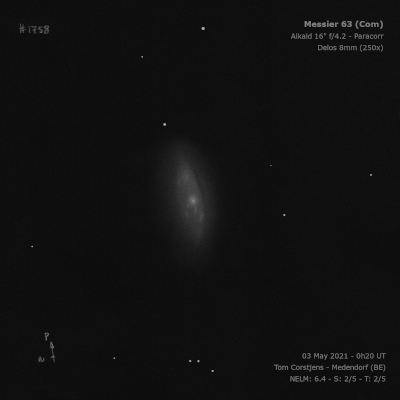
Pierre Méchain discovered M63 = NGC 5055 = h1570 on 14 Jun 1779. On 18 Mar 1787 (sweep 717), William Herschel recorded "E from np to sf., 5 or 6' long and near 4' broad, a bright nucleus, very brilliant." On 9 Apr 1787 (sweep 725) he logged "vB, 9 or 10' long, considerably broad, the brightness confined to a small place." JH logged "B; pmE; vsmbM, almost to a *, pos 30° np to sf. The sf end more diffused. Has a bright star np and a double star following."
On 9 Mar 1850, LdR (or observing assistant George Johnstone Stone) noted M63 was "another fine and bright spiral." Later observations couldn't confirm the spirality, though the galaxy is included in the list of 14 "Spiral or curvilinear" nebulae in LdR's 1850 PT paper.
Basen on Mt Wilson 60-inch photographs, Pease (1918) described M63 as a "bright, beautiful spiral 8' x 3' in p.a. 98°. Has an almost stellar nucleus. The whorls are narrow, very compactly arranged, and show numerous almost stellar condensations."
300/350mm - 13.1" (5/26/84): very bright, elongated NNW-SSE, broad moderate concentration, stellar nucleus. The southern edge is more sharply defined while the northern side is more diffuse and extensive. A mag 8.5 star is off the NW edge.
400/500mm - 17.5" very bright, large, elongated 2:1 WNW-ESE, 6'x3'. There is a faint outer extension to the WNW (outer spiral arms?) that reaches extremely close to mag 8.7 SAO 44530 just 3.7' from the center.
900/1200mm - 48" (4/20/17): This gorgeous spiral is sharply concentrated with a bright, mottled oval core that increases to an intensely bright nucleus. Several low contrast dust lanes surround the core, particularly on the south side of the core, separated thin sections of spiral arms. A long, relatively broad dust lane crosses the halo E-W, roughly 2' south of center. A very low surface brightness arm or section of the outer halo is visible beyond (south) of this dust lane. A mag 9.3 star is superimposed in the outer halo [3.7' WNW of center].
48" (4/7/13): The "Sunflower Galaxy" is a classic example of a floccelent spiral with many short fragments forming the arms. At 375x it appeared extremely bright and large, elongated 2:1 WNW-ESE, 8'x4'. A large, intense, mottled core increases to a small, brilliant nucleus. The outer halo was resolved into several tightly wrapped spiral arcs that are separated by thin dust lanes. The arm structure is most evident along the south side of the galaxy with the easiest arm at the outer edge, particularly where it separates at the western end. The galaxy extends just beyond a mag 9.3 star (HD 115270) at the northwest edge.
UGCA 342, probably a detached section of the outer halo of M63, lies 8' WSW of center and 1.2' S of a mag 10.7 star. It appeared extremely faint, fairly small, elongated 2:1 E-W, 20"x10", very low surface brightness.
Notes by Steve Gottlieb
NGC 4449
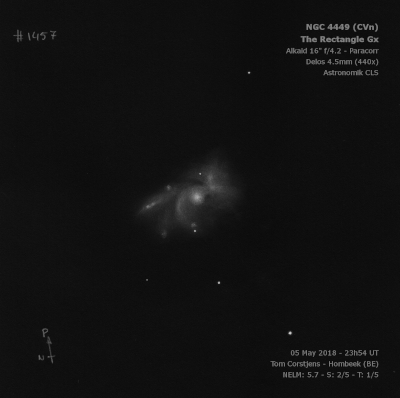
William Herschel discovered NGC 4449 = H I-213 = h1281 on 27 Apr 1788 (sweep 833) and recorded "very brilliant, cL, E from sp to nf, difficulty r, seems to have 3 or 4 B nuclei." His sketch at the end of 1811 PT paper (reproduced in Stenicke's book) clearly shows 4 condensations or HII knots within the glow, though one of these may be the nucleus. He used this an illustration of "Nebulae which are brighter in more the one Place." According to Wolfgang Steinicke, Caroline Herschel was next to find the object on 8 Jul 1793 in her 4.2-inch reflector, "and assumed it to be a comet!"
On sweep 150, John Herschel recorded "B; L; gbM; E in pos 75° nf to sp, a fine cluster; well resolved; I see several of the stars; 3' l, 2' br." On sweep 248 (last of 4 observations), JH wrote "vF; vL; vmE; it is either a double nebula or the nf end is bifid. If double the companion is F; R; bM; nearly north 1.5' or 2'. A fine object." So, clearly WH and JH resolved several HII regions in this galaxy. Lord Rosse or assistant Johnston Stoney noted on 17 Mar 1849, "3 nuclei or 2 nuclei and star, and faint neb outlying."
Based on photographs taken with the 60-inch reflector at Mt Wilson, Francis Pease (1917) described NGC 4449 as "..an irregular nebulous mass in which many nebulous stars [HII regions] are distributed unevenly. The greater part of the nebula is roughly rectangular, about 4.5'x2.5', p.a. = 40°, there being an assemblage of some dozen nebulous stars W of the SW corner. On the original negative there are 230 nebulous stars or patches...Two-thirds of them are in the N half. The nebulosity proper is weak toward the edge, gradually increases inward, and culminates along a central ridge, where it is as strong as the stars themselves. A number of dark irregular rifts appear here and there in it."
200/250mm - 8" bright, moderately large, elongated, bright core.
300/350mm - 13.1" (4/12/86): very bright, very large, elongated SW-NE, bright core, stellar nucleus. A knot is involved at the north end and the galaxy generally appears brighter to the north of the core. A star is superimposed close east of the core.
400/500mm - 18" (5/14/07): very mottled, irregular appearance, elongated ~2:1 SW-NE, ~5'x2.5'. The core is quite splotchy in appearance with a couple of bright knots; the most prominent is attached to the southwest of the core. The main body is roughly rectangular with an extension at the northwest "corner" that ends with a bright knot or knots ([HK83] #15). Another extension or knot ([HK83] #2) is off the northeast corner. A mag 13 star lies 2.4' E of the core and 1 or 2 additional very faint stars or knots are superimposed in the central region.
18" (5/8/04): fascinating view of this "Magellanic" system at 323x! The galaxy is very irregular in appearance and surface brightness with a large, bright, elongated core oriented SW-NE. The core appears offset to the south side of the galaxy.
Several knots (giant HII regions) are visible outside the core. The brightest is a well-defined obvious patch on the north edge of the galaxy, 1.5' from the center. This object is #15 in Hodge-Kennicutt's 1983 "Atlas of HII regions in 125 galaxies" ([HK83]) and it is nearly comparable in surface brightness to the core. Roughly 1' SE is #2, a smaller, faint knot that is collinear with #15 and a mag 13.5 star 2.4' E of the core. #25, a third difficult knot, can sometimes be glimpsed about 40" SW of #15. Finally, attached on the south end of the core is a larger, bright knot, although initially I thought this was just part of the core.
900/1200mm - 48" (2/20/12, 3/1/19, 5/1/19): NGC 4449 is a boxy-shaped Magellanic-type Irregular containing several bright, giant HII regions that are sites of active star formation. The galaxy has been intensively studied as one of the strongest galaxy-wide starbursts in the nearby universe. The overall surface brightness of the galaxy was unusually high at 375x. The very bright central region is elongated SW-NE, irregular in surface brightness and contains a small, intense "nucleus". This object is identified in SIMBAD as [GHG2001] 1 and described as a 10 Myr old super star cluster in the 2001 study by Gelatt et al, "The Star Clusters in the Irregular Galaxy NGC 4449".
To the southwest is a fairly large, bright patch that mimics a second core. This region is catalogued as #27/28/30 in Hodge-Kennicutt's 1983 "Atlas of HII regions in 125 galaxies" [HK83]. Several addition patches are on the north end of the galaxy. The largest and brightest is #15, a high surface brightness irregular glow at the north end of the galaxy, 20"x12", with a mottled surface and a stellar knot (#11) at the north tip. Roughly 35" SW is #25, a moderately bright roundish knot of ~12" diameter. 20" W is #31, a fairly faint, small HII knot, less than 10" in diameter. At the northeast tip of the galaxy is #2, nearly 1' SE of #15. It appeared as a moderately bright knot, ~15"-20" in size. A small knot (#16) was noted on the southeast side of the galaxy. A faint 12" knot is nearly detached at the SW end of galaxy (#6 in the 1969 "Kinematic study of ionized hydrogen in NGC 4449"). Very low surface brightness haze extends west off the SW end. A mag 14 star is superimposed [44" ENE of the nucleus].
On 5/1/19, I had the strong impression of an extremely low surface brightness glow nearly 10' SE of the galaxy (and 2.4' W of LEDA 2233323). This is the location of a tidal star stream, discovered in 2011.
Notes by Steve Gottlieb
NGC 4490
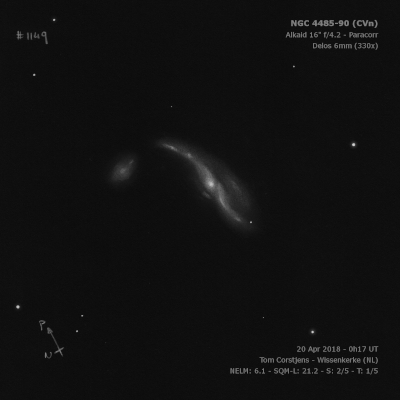
William Herschel discovered NGC 4490 = H I-198 = h1308, along with NGC 4485, on 14 Jan 1788 (sweep 798) and recorded "Two, the most south [NGC 4490] vB, vL, iE. That to the north B, pS, iF, about 1 1/2' distance." JH logged "vB; vL; mE; 40° np to sf; easily resolvable."
An accurate sketch was made of NGC 4485 and 4490 at Birr Castle on 27 Mar 1856 (figure 23, Plate XXVII in the 1861 publication). It showed the northwest tip curling towards NGC 4485 and a faint streak, corresponding to a string of HII regions, along the north edge of the galaxy.
300/350mm - 13.1" (2/16/85): very bright, large, striking, elongated 2:1 NW-SE, 6'x3', large bright core is elongated and grainy. A very faint arm extends from the NW end in the direction of NGC 4485 3.6' NNW. A small extension (arm) at the SE end is suspected. Similar view and sketch made on 2/23/85. On 4/12/86, just a hint of curvature was noted towards NGC 4485.
400/500mm - 18" (6/7/08): I viewed this interesting pair in my 15x50 IS binoculars (just a faint blur), 18" Starmaster (disturbed arm on the WNW end extending towards NGC 4490 easily visible) and the 33.4" f/5 (internal structure visible).
18" (6/13/07): very bright, large, elongated 5:2 WNW-ESE, ~5'x2', with a very bright oval core, ~45"x30". The surface brightness is irregular or mottled but most interesting is a small extension or arm that juts out of the WNW end and appears to bend or hook north towards the companion NGC 4485. There appears to be a smaller counterpart at the ESE end that slightly protrudes from the main body. With averted vision, the galaxy grows wider and appears ~5'x2.5'. Located 39' NW of mag 4.3 Beta CVn. Member of the CVn II Group (brightest member M106).
18" (6/4/05): very bright, large, elongated 2:1 NW-SE, contains a large, bright core. At the northwest end a faint arm appears to emerge hooking sharply to the north for 1' towards NGC 4485. At the southeast end, there appears to be slight extension without much curvature near a 16th magnitude star. The central region is weakly concentrated to the center. Overall, the galaxy has a mottled, slightly splotchy appearance as if was dusty or knotty with HII regions. Located 40' NW of 4.2-magnitude Beta Canum Venaticorum.
600/800mm - 24" (5/27/17): very bright, large, elongated ~5:2 WNW-ESE, ~5'x2.2', fairly high but irregular surface brightness, brighter core, but seems offset from center. A long arm (somewhat detached from the brighter central region), sweeps WNW and curls north near the end (bending towards companion NGC 4485). Fascinating unusual structure.
900/1200mm - 48" (5/1/19): at 375x; several HII knots were identified along the north side of this remarkable galaxy. NGC 4490:[VS65] 19, 22 and 23 are three very close, tiny knots oriented WNW-ESE [total length 22"] along the north edge of the central region. The middle knot (#22) was the brightest but only ~6" and the last knot (#23) was the faintest. NGC 4490:[VS65] 02 was a fairly bright, elongated glow on the NW edge of the galaxy [1.8' from center]. On close inspection it resolved into two extremely small knots. These designations are from 1965 study of HII regions in NGC 2403, 2903 and 4485/4490 by Véron and Sauvayre.
Notes by Steve Gottlieb
NGC 4244
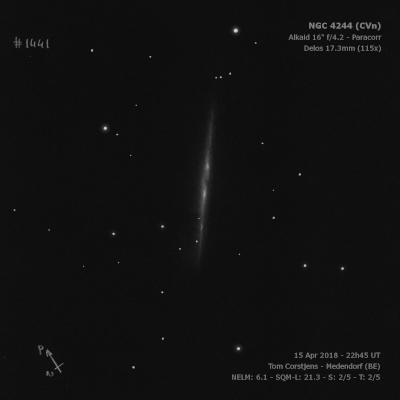
William Herschel discovered NGC 4244 = H V-41 = h1167 on 17 Mar 1787 (sweep 714) and recorded "cB or vB, vgbM, 18 or 20' l, about 2' broad, from about 60 degrees sp to nf." Member of the CVn I cloud (distance ~15 million light years)
300/350mm - 13.1" (4/12/86): fairly bright, extremely large edge-on about 10:1 SW-NE. Extends to 15' diameter (fades at the ends of the extensions). Appears as a narrow ray with only a weakly concentrated core.
400/500mm - 18" (6/4/05): beautiful, extremely large ray extends at least 3/4 across the 20' field, ~15'x1' SW-NE. The galaxy is broadly concentrated without a well-defined core or nucleus and bulges only very slightly at the center. The surface brightness is fairly low and only varies gradually over the entire length, though it has a grainy texture. A mag 13.5 star is near the NE end. Member of the M94 Group (CVn I Cloud).
Notes by Steve Gottlieb
NGC 4656
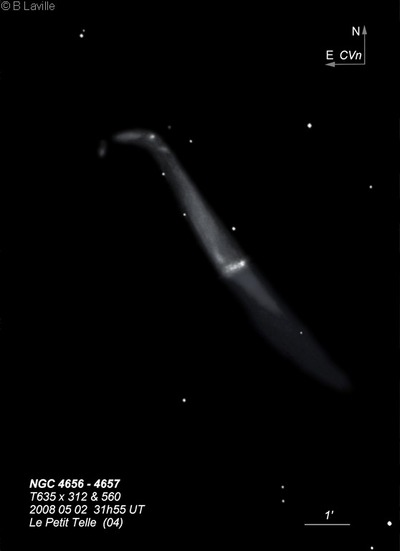
William Herschel discovered NGC 4656 = H I-176 = h1414, along with NGC 4657, on 20 Mar 1787 (sweep 722) and recorded "Two, their nebulosity join; they are both elongated and together form the shape of the letter "S". The most south [NGC 4656] cB, mbM. The most north NGC 4657], pB from sp to nf, but very near the meridian. John Herschel made a total of 5 observations. In sweep 342 he noted, "a long nebulous ray pos = 34.3° (by micrometer). Its southern half is fainter than its northern. It meets and cuts? another nebula NGC 4657]. A strange object." A sketch was published in plate 15, Figure 75 in his Slough Observations.
Bindon Stoney sketched the pair at Birr Castle on Apr 26 1851 (included in LdR's 1861 publication). The following year he called this pair "like a caterpillar on a leaf."
300/350mm - 13.1" (4/10/86): striking!, fairly bright, very elongated SW-NE. Appears wider and brighter at the SW end. The NE end hooks sharply east to merge with NGC 4657 which may be a part of NGC 4656 and not a separate galaxy. A star or knot is attached at the south end. Appears like a celestial hockey stick!
400/500mm - 18" (5/14/07): this fascinating galaxy forms one of the most striking pairs in the sky with NGC 4631 32' NW. At 220x, the distorted shape extends ~9'x1.5' in a SW-NE orientation. On first glance, it appears the bulging core is offset at the SW end, though with averted vision a very low surface brightness broader extension continues to the the SW of the core for several arcminutes before fading into the background. The core is very bright and mottled with a bright knot (HII region) jutting out to the west at the southwest end of the core. The NE extension has a remarkable, fairly bright 2' extension (NGC 4657), hooking to the east at a 45° angle from the major axis (the "blade" of the hockey stick). There is a small, faint, detached knot beyond the east end of the "blade" that appears to have broken off. The unusual bend and knot at the NE end is a result of a prior tidal interaction with its more massive neighbor, NGC 4631.
900/1200mm - 48" (4/23/17): this showpiece galaxy was viewed at 375x and 488x and the structure/details was very comparable to the POSS2. The galaxy extended ~8'x1' SW-NE, though it has a much lower surface brightness on the SW end. It is well concentrated with a very bright and large, elongated core on the south end of the brighter half, giving a very asymmetric appearance. A bright stellar or quasi-stellar knot is at the southwest edge of the core (this is a huge star cloud on the HST image identified in SIMBAD as [BKD2008] WR 462, from a 2008 paper on Wolf-Rayet features). A faint (17th mag?) stellar object is close east.
The low surface brightness southwest portion of the galaxy to is broader than the northeast section. It includes a faint, quasi-stellar knot (identified in SIMBAD as CasHII N4656a, from a 1984 Case University survey of HII regions in blue galaxies) along the western edge with a SDSS magnitude of 17.8V.
At least 4 main HII complexes are at the northeast end of the galaxy (NGC 4657), including a separate detached section. On the southwest edge is a bright knot, ~8" diameter, catalogued in SIMBAD as CasHII N4656f and in NED as NGC 4656:[DBT2008] 85 from a 2008 paper on massive clusters. A brighter 10" knot, identified in NED as 2MASX J12440599+3212340, is ~20" N, also along the west edge of the NE extension. The northeast end of the galaxy (NGC 4657) has a sharp extension to the east with a slightly brighter patch, identified in NED as 2MASX J12440844+3212340. Finally a bright, elongated patch ~30"x15" oriented NNW-SSE is detached to the east. SIMBAD identifies this object as(NGC 4657, though the NGC designation should probably apply to the entire bent NE end of the galaxy.
Notes by Steve Gottlieb
NGC 4214
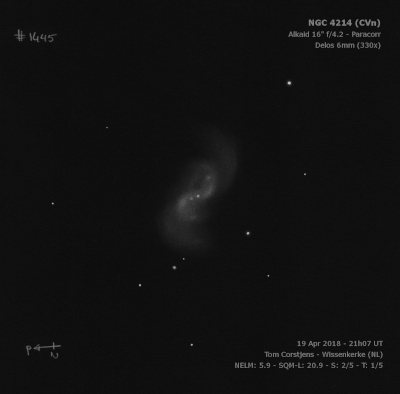
300/350mm - 13.1" (4/12/86): bright, large, slightly elongated NW-SE, bright core. There is a strong impression of curvature at the ends of the major axis. A mag 11 star lies 4.3' SE of center. Member of the M94 Group (CVn I Cloud).
Notes by Steve Gottlieb
NGC 4395
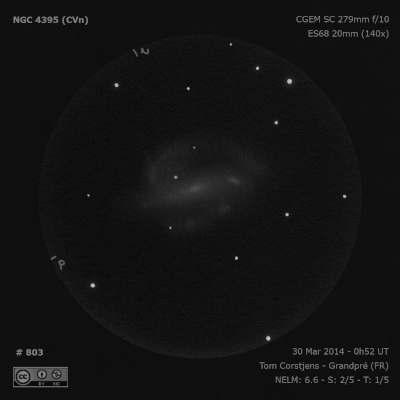
William Herschel discovered NGC 4395 = H V-29.1 = h1252 on 2 Jan 1786 (sweep 508) and recorded "eF, vL, vlbM, resolvable, about 10' long and 8 or 9' broad." JH made two observations, logging on 29 Apr 1827, "two nebulae running into one another; both eF, vL, the f rather the brighter. Place that of the preceding." Dreyer catalogued the two components as NGC 4395 = V 29.1 and NGC 4401 = V 29.2. On a second observation, JH wrote "vL; extremely ill defined, may perhaps be 10' l, 3' br; pslbM to an irregular centre. On closer inspection bicentral; pos of the nuclei 30° np; dist 2'."
This galaxy was viewed on three occasions at Birr Castle by Bindon Stoney, who recorded "a cluster of nebulae found" on 13 Apr 1850 and "there are 4 nebulae. The 3 f ones seem to be inv in a mass of F neby." Based on these observations, Dreyer included two additional entries: NGC 4399 and NGC 4400. The sketch of these condensations match up well with my own observations with a 17.5" and can be identified on the POSS.
300/350mm - 13.1" (4/12/86): at 62x appears very large, diffuse, slightly elongated glow, broad very weak concentration.
400/500mm - 17.5" (5/15/99): this chaotic galaxy is dominated by several bright HII regions. At 100x, the large low surface brightness glow is clearly clumpy with a couple of faint knots evident on the east side of the haze. At 220x, the glow of the galaxy is more difficult to view and several nonstellar knots and a couple of very faint superimposed stars are more prominent. The brightest HII region is NGC 4401 located 2' SE of the core, ~25" in size, with a second smaller 15" knot (NGC 4400) close south. The core of the galaxy appears as an ill-defined, low surface brightness glow, larger than the individual HII knots. A mag 14.5 star is superimposed NE of the core. On the SW side of the core is a third difficult knot, about 15" in diameter (NGC 4399) requiring averted vision to confirm. Member of the M94 Group (CVn I Cloud).
17.5" faint, very large, extremely low surface brightness, must use low magnification to view. Three knots are involved (one of these observed "knots" may be the core) within a very diffuse glow. The brightest knot NGC 4401) is at the SE end about 2' SE of center with(NGC 4400 close SSW of NGC 4401. A mag 14.5 star is at the north end. Also see description for(NGC 4399.
Notes by Steve Gottlieb
NGC 5195
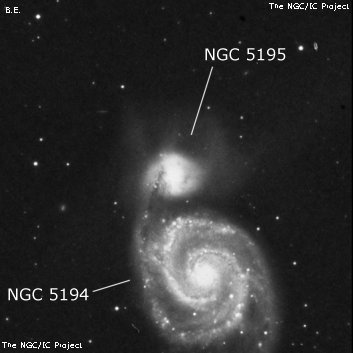
Pierre Méchain discovered the northern component of M51 or NGC 5195 = H I-186 = h1623 on 20 Mar 1781 and commented "saw this nebula; effectively it is double. The center of each is brilliant and clear; distinct and the light of each touches each other." Messier mentioned this companion to M51 in his 1784 version of the catalogue in Connaissance de Temps, though it never received recognition as a separate Messier object. WH found it on 12 May 1787 (sweep 734) and recorded "B, S, R, vgbM. Just north of the former M51]." JH reported "B; R: vsbM to a star. This nebula is the companion of M51 and is figured with it."
LdR and assistants described NGC 5195 as probably a spiral on several observations and other details were noted. On 17 Mar 1855: "I have no doubt of a spiral arrangement of the smaller Nucl." On 16 Apr 1855: "The 2nd Nucl seems to be the proper prolongation of the spiral arm with which it is connected." On 18 Apr 1860: "I still think the small Nucl is shaped like an "S". On 12 Apr 1872: "The edge of the 2nd convol. is very nearly rectilinear on the south side."
300/350mm - 13.1" bright, fairly small, very irregular appearance. Forms a double system 4.6' N of M51 and connected on the east side by a faint spiral arm of M51 which trails north on the east side to NGC 5195. The following side is sharply cut-off due to dust and appears as a half disc.
900/1200mm - 48" (4/2/11): I was shocked by the detail and structure visible in the companion to M51 at 375x. The main 2' portion of the galaxy has a striking asymmetric appearance with an extremely high surface brightness "bar" perhaps 2'x0.8' elongated N-S with a sharp light cutoff on the east side. Attached on the east side of a bar is semi-circular "loop" extending about a 1' E and connected at the north and south end of the bar. The western loop portion of NGC 5195 was slightly brighter where it connected at the ends and the interior of this loop was irregularly darker. On first glance there appeared to be an obvious short "arm" connected to the northeast end of NGC 5195 heading south, but then I realized this was the long connecting arm from M51 that brightened in the last 1' where it attaches to NGC 5195. The entire connecting arm was always a prominent direct vision feature of the pair. The center of the bar was sharply concentrated with an extremely bright, quasi-stellar nucleus.
At least three distinct plumes of nebulosity (referred to as the "crown") extended from NGC 5195 to the north. A broad wing of hazy nebulosity begins near the NE end (at the end of the connecting arm) and sweeps 2' to the north in a gentle curve. A second shorter plume extends directly north from the north end of NGC 5195. Finally a mass of very low surface brightness nebulosity spreads to the west from the southwest end of the galaxy and clearly sweeps towards the north for ~2.5'.
Notes by Steve Gottlieb
NGC 5371
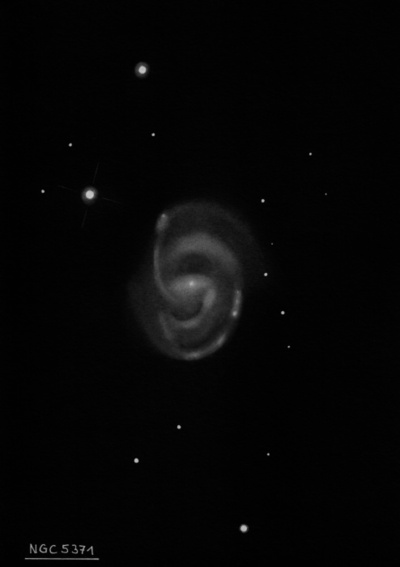
200/250mm - 8" (5/21/82): fairly bright, fairly large, diffuse oval halo.
300/350mm - 13.1" (5/26/84): bright, fairly large, small bright nucleus, slightly elongated N-S. Located 2.5' SW of mag 9.1 SAO 44805. The NGC 5353 group lies 25' WSW.
600/800mm - 24" (7/1/16): very bright and large, elongated 4:3 N-S, contains a relatively small brighter core that is slightly elongated E-W (central bar). The large outer halo shows spiral structure. An arm on the north side sweeps west and south and a more ill-defined arm on the east side extends to the north. A mag 9 star is 2.6' NE. The HCG 68 quintet (including NGCs 5350, 5353 and 5354) is ~25' SW. Brightest in a large group (LGG 361) with 13 NGC galaxies.
Notes by Steve Gottlieb
NGC 4111
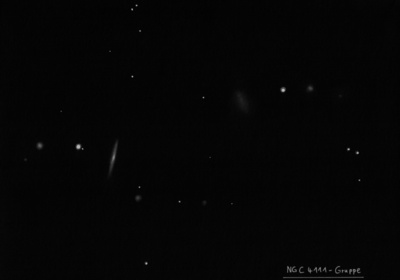
William Herschel discovered NGC 4111 = H I-195 = h1088 on 14 Jan 1788 (sweep 798) and recorded "E sp nf, vBN with faint branches. His position and description matches UGC 7103. On 6 Feb 1788 (sweep 810) he made another observation and also discovered NGC 4117. John Herschel first recorded (sweep 150) "B; S; mE; sbM; a double star point to its nucleus."
300/350mm - 13.1" (4/12/86): fairly bright, pretty edge-on, small very bright core, faint thin arms. Located 5' SW of a mag 8 star. In a group with NGC 4109 5' SSW and NGC 4117 8.5' WSW.
400/500mm - 17.5" fairly bright, fairly large, edge-on 5:1 NW-SE, small very bright core, long thin extensions. A double star with components mag 8.2/10.7 at 34" separation lies 3.8' NE. Brightest in a group with NGC 4109 4.8' SW and NGC 4117 8.7' WSW.
600/800mm - 24" (5/30/16): at 225x; very bright, beautiful edge-on ~7:1 NNW-SSE, 3.5'x0.5'. Sharply concentrated with a small very bright elongated core, with an unusually bright quasi-stellar nucleus. An extremely faint star or stellar knot was suspected near the southeast end. A very wide unequal pair (HJ 2596) with a orange mag 8.1 primary lies 3.7' NE.
NGC 4111 is the brightest in a group (LGG 269 = UMa NED4 Group) containing NGC 4109 4.8' SSW (background object), NGC 4117 8.6' NE, NGC 4118 9.4' NE, UGC 7094 11.6' SW and UGC 7089 12.8' NW. All of these galaxies with the exception of UGC 7089 are roughly aligned in a 20' string oriented SW-NE. UGC 7094 appeared very faint, very elongated 4:1 SW-NE, 1.0'x0.25', very low surface brightness with no noticeable concentration.
900/1200mm - 48" (3/1/19): at 488x; stunning edge-on ~8:1 NNW-SSE with a bulging core, ~4.0'x0.5'. Sharply concentrated with an extremely bright, very elongated bulging core. The nucleus is very small and brilliant! Due to dust lanes that run perpendicular to the major axis, the galaxy was slightly brighter on the centerline of the major axis on both sides of the core. The arms taper slightly with a spindle appearance. A very faint star (~17th mag) is at the SW end of the galaxy.
Notes by Steve Gottlieb
NGC 4618
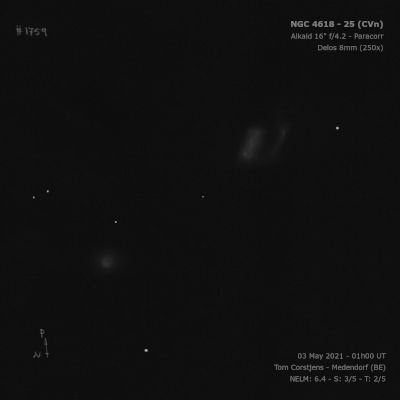
300/350mm - 13.1" (4/12/86): moderately bright, fairly large, faint elongated halo with large brighter core which appears displaced towards the north. This is an unusual one-armed spiral galaxy with a more extensive halo on the south side. Forms a pair with NGC 4625 8.3' NNE. IC 3668 is a knot in the southern arm.
400/500mm - 18" (5/15/10): This is a very unusual, asymmetric Arp galaxy with a single massive arm (similar to NGC 4027). At 220x it appeared bright, fairly large, obviously irregular, with a slightly elongated main body ~2'x1.5', extended 4:3 SW-NE. Within the main portion of the galaxy a brighter, elongated bar was visible, roughly 1.5'x0.5'. The central bar, though, is displaced to the NW side of entire glow as extending mostly to the south side is a faint, beefy arm that often appears detached and barely connected on the east end of the central region. This broad arm winds counterclockwise from east to south roughly 100° with IC 3668, the brightest region or knot near the south end of the arm, ~1.8' from the center of the bar. This single arm increases the overall size to ~3'x2'. IC 3369 refers to the brighter SE portion of the spiral arm.
900/1200mm - 48" (4/7/13 and 4/19/17): fascinating one-armed asymmetric spiral (Arp 23). At 488x the core region is offset to the north side and appeared extremely bright, irregular, elongated 5:3 SW-NE, 1.6'x1.0'. A prominent, thick, knotty arm is attached on the northeast end and sweeps counterclockwise to the south and then west. It includes a small, round knot (listed in NED as infrared source SSTSL2 J124136.60+410900.6), 0.8' due east of center. IC 3669 is a brighter arc or section of the arm, about 1' southeast of the core. IC 3668 appears as a bright, elongated HII region(s) at the south end of the arm (1.7' south of center), ~20"x10". The arm continues to rotate towards the north on the west side of the galaxy, but this feature has a very low surface brightness and ends roughly west of the core. Only a faint, diffuse glow with no structure was seen to north of the core. The total size of the galaxy extended 3.5'x2.5'. NGC 4618 forms a pair with NGC 4625 8.3' NNE. Interestingly, both galaxies have single prominent arms, though the arm in NGC 4625 was more subtle visually. Member of the CVn II Group, with brightest member M106.
Notes by Steve Gottlieb
NGC 5023
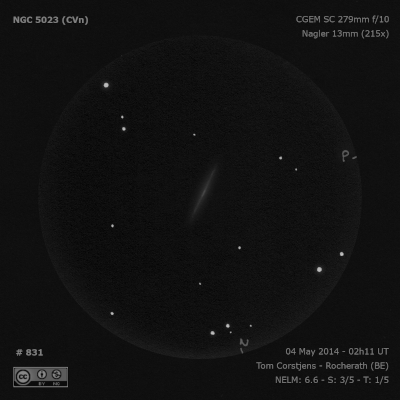
William Herschel discovered NGC 5023 = H II-664 = h1559 on 9 Apr 1787 (sweep 725) and recorded "pB, mE from sp to nf, about 5' l and 3/4' br." JH made two observations and his mean position is accurate. NGC 5023 is one of the flattest NGC galaxies.
400/500mm - 17.5" (4/21/01): moderately bright, large, thin edge-on streak SSW-NNE, 4.0'x0.4', slightly brighter center. Member of nearby group LGG 347 along with M51! A 1' pair of mag 10/11 stars lies 9' NW.
Notes by Steve Gottlieb
NGC 4151
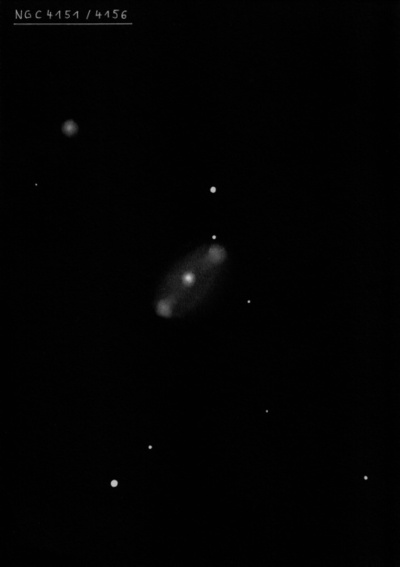
William Herschel discovered NGC 4151 = H I-165 = h1111, along with NGC 4156, on 17 Mar 1787 (sweep 714) and recorded "vB, A bright nucleus, but the nucleus not in the middle, or perhaps two joined together, the northern on having the nucleus." CH's reduction is on the northwest side of the halo.
On 26 April 1851 at Birr Castle, Bindon Stoney logged "Has a B, R centre with nucleus, then two dark spaces concentric with the nucleus and outside these faint nebulosity as in figure." Two night laters he noted "Previous observation rather confirmed. The dark spaces certainly exist, but I cannot be sure that appendages are not parts of spiral branches." The following year he wrote "Last year's observation confirmed as to dark curved spaces preceding and following centre and faint nebulosity outside them again." A sketch was included in the 1861 publication (Plate XXVII, Fig. 20).
NGC 4151 is one of the 6 galaxies studied by Seyfert in his seminal 1943 paper "Nuclear Emission in Spiral Nebulae".
300/350mm - 13.1" (3/17/86): very bright, very small or stellar nucleus, fainter halo. A mag 11.5 star is 2.3' N and a closer mag 13 star is 1.3' N of center. Forms a optical pair with NGC 4156 5.1' NE (the companion is in the background). NGC 4145 lies 29' N.
Notes by Steve Gottlieb
NGC 5353
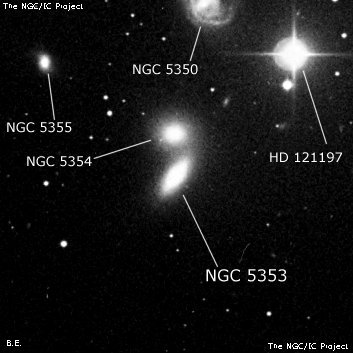
William Herschel discovered NGC 5353 = H II-714 = h1698 on 14 Jan 1788 (sweep 799) and recorded "Two [along with NGC 5354], pB, both S, R, at 2' distance in the meridian." JH logged "The southern of a double neb, dist 1' in meridian." and "pB; S; the southern of 2 nearly in meridian; the second of a group of 4."
200/250mm - 8" (5/21/82): moderately bright, small.
300/350mm - 13.1" (5/26/84): brightest in the NGC 5353 group = HCG 68. Fairly bright, oval 2:1 NW-SE, gradually increases to a small bright core. Forms a close pair with NGC 5354 1.2' N. Other nearby members are NGC 5350 4.9' NNW, NGC 5355 4.9' NE, NGC 5358 6.4' E. Located 4.8' SE of mag 6.5 HD 121197.
600/800mm - 24" (6/3/19): at 200x; type Ia SN 2019ein, discovered on May 1st, appeared as a mag 15 "star" just off the SE end of the galaxy (28" E and 28" S of center). This supernova peaked at mag 14.0.
24" (7/1/16): very bright, fairly large, elongated 5:2 NW-SE, ~1.8'x0.7', sharply concentrated with a very bright elongated core that increases to the center. Forms a contact pair with NGC 5354 (two brightest members of HCG 68), with centers 1.2' apart.
24" (6/8/13): the brightest member of HCG 68 appeared very bright, fairly large, elongated 5:2 NW-SE, 1.8'x0.7', well concentrated with a very bright elongated core that increases to the center. Forms a contact pair with NGC 5354 1.2' N. NGC 5358 = HCG 68E lies 6.4' due E. NGC 5371, the brightest and largest in a larger group (LGG 361) including HCG 68, lies 27' NE
Notes by Steve Gottlieb
NGC 4217
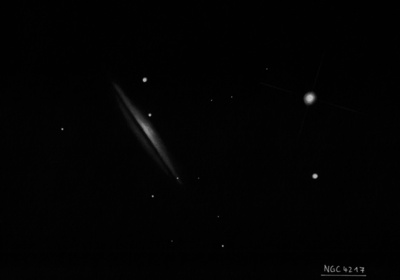
William Herschel discovered NGC 4217 = H II-748 = h1149 on 10 Apr 1788 (sweep 830) and recorded "pB, pL, sp and in a line with two stars." JH made 5 observations and logged (sweep 255) "pB, vmE in pos = 225° by measure; 5' long, 1' br; 2 stars near and a large star preceding." on 15 Mar 1849, LdR or observing assistant George Stoney described it as a "Ray with split [dark lane] in the direction of the major axis".
300/350mm - 13.1" (4/12/86): moderately bright, pretty edge-on 4:1 SW-NE. A mag 9 star is off the NE edge 2.2' from the center and a mag 11.5 star is just north of the core 0.8' from center. Located 6.2' E of mag 7.3 SAO 44092. Forms a pair with NGC 4226 7' SE.
900/1200mm - 48" (4/23/17): bright, very large, striking edge-on ~4.5'x1.0' SW-NE, large bright core that bulges near the center but no distinct nucleus. The galaxy is bisected by a beautiful, relatively wide dust lane that slices through the entire length of the galaxy, only losing contrast at the very tips! The brightest portion, including the core, is on the north side (northwest facing) of the dust lane. The cut off section of the galaxy on the south side (southeast facing) of the the dust lane is fairly thin and low surface brightness, though slightly brighter at the center/core. A mag 14.8 star is at the southwest tip of the galaxy. A mag 11.6 star is at the edge of the halo on the north side [50" from center] and a 9th magnitude star is 2.3' NNE of center. The galaxy is situated 6' E of mag 7.2 HD 106556, though this star was kept outside the field. NGC 4226 lies 7' SE. Member of the M109 (NGC 3992) group = LGG 258.
Notes by Steve Gottlieb
NGC 5350
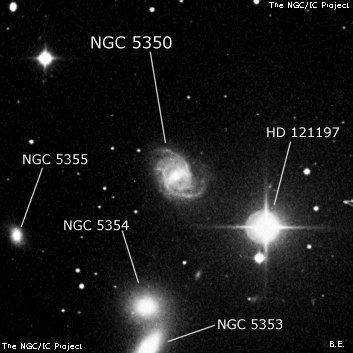
William Herschel discovered NGC 5350 = H II-713 = h1696 on 14 Jan 1788 (sweep 799) and noted "F, pL". JH made two good observations, noting "pB; R; bM" and "vF; L; a bright D * preceding; the first of 4."
200/250mm - 8" (5/21/82): faint, moderately large, diffuse, between two stars mag 6.5 and 9.0.
300/350mm - 13.1" (5/26/84): largest galaxy in the striking NGC 5353 group = HCG 68. Fairly faint, diffuse, slightly elongated, very weak concentration, no core. Located on a line between mag 6.5 HD 121197 2.9' SW (not in SAO) and mag 9.3 SAO 44789 5.0' NE. First in the group with NGC 5354 3.7' SSE, NGC 5353 4.9' SSE, NGC 5355 4.9' ESE and NGC 5358 9.0' SE.
600/800mm - 24" (7/1/16): fairly bright or bright, oval ~4:3 ~N-S, ~2'x1.5', largest in the HCG 68 quintet. Contains a brighter core with a subtle bar oriented NW-SE. The center increases gradually to a stellar nucleus. The surface brightness is irregular with hints of structure including an arc or spiral arm on the northeast side. The mag 6.5 orange star HD 121197 is 3' SW.
24" (6/8/13): bright, large, contains a brighter core or bar that is oriented NW-SE. The central core of the bar is round and increases somewhat to the center. The 2.0'x1.5' halo, though, is elongated 4:3 SSW-NNE. Located 2.9' NE of a mag 6.5 star with NGC 5353/5354 ~4' SSE and NGC 5355 ~5' ESE.
Notes by Steve Gottlieb
NGC 5395
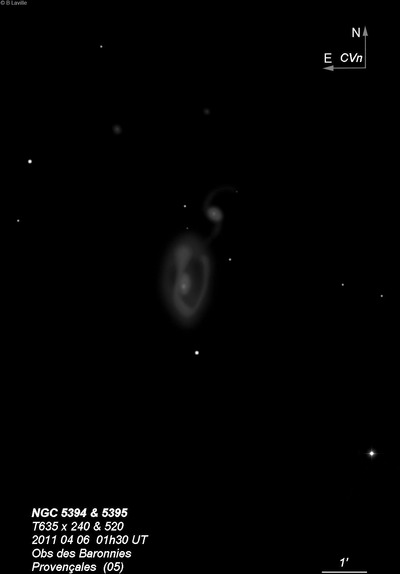
William Herschel discovered NGC 5395 = H I-190 = h1723, along with NGC 5394, on 16 May 1787 (sweep 738) and recorded "Two, that of the south [NGC 5395] cB, cL. Distance about 1.5'." John Herschel made 3 observations and measured a fairly accurate position.
Spiral structure was recorded several times at Birr Castle, though the observations are listed in the 1861 and 1880 publications under h1713 = GC 3717 = NGC 5378. On 24 Apr 1854, R.J. Mitchell logged "centre pB; oval ns, among sev st. I thought the n end the broader and suspected a dark space preceding nucleus. A pB patch of neby np." On 1 May 1854 he added "Singular object; the main body of neb has a B Nucl and is E ns, the southern end bends back suddenly at a sharp angle and extends np past the neb, ending in a B, R patch or Nucl." On 19 Feb 1855, he reported "Neby seems to reach the knot np. There is knot or star in the arm p and some condensation in the centre of neb. I think F neby reaches up to the star north. Finally, he sketched the pair on 17 Apr 1855 and noted "Mr Johnstone Stoney [who was visiting between professorial duties at Queen's College Galway] saw the p branch extend round the south end of the main neb and continued on to the north, when after a second turn it joined the nucleus."
400/500mm - 17.5" (6/6/86): fairly bright, elongated NNW-SSE, bright core, small bright nucleus. A mag 13.5 star is off the south edge 1.7' from center. There is an impression of a dark lane on the west side and an extremely faint arm beyond the lane (agrees with POSS). Forms a contact system with NGC 5394 at the NNW edge!
900/1200mm - 48" (4/1/11): the Heron Galaxy was a remarkable interacting pair at 375x and 488x. The main galaxy (NGC 5395) was extremely bright, elongated 5:2 N-S, 2.5'x1.1', contains a blazing 30" core and a mottled, clumpy appearance. The most prominent feature is a well-defined, long arm that begins to the north of the core and wraps all the way around the core. This arm shoots past the core just to its east and heads directly south. The knotty arm then tightly curves back around towards the north on the west side, extending the full length of the galaxy and angling slightly towards smaller NGC 5395. A dark lane separates the core region from the arm on the west side. An irregular extension (or part of an arm) branches north from the main arm on the north side of the core and culminates at a brighter region or knot at the north end of the galaxy. NGC 5394 is 1.9' NW of center and one of the arms of this galaxy attaches to NGC 5395 on the NW side.
Notes by Steve Gottlieb
NGC 5005
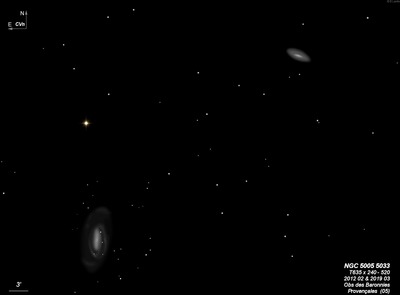
William Herschel discovered NGC 5005 = H I-96 = h1547 on 1 May 1785 (sweep 405) and recorded "vB, mE nearly in the parallel. The faint rays included, about 5' long; the vB part of it, about 1.5' long; the brightness decreasing very suddenly." JH made two observations, described on sweep 73 "vB; vL; mE; 4' l, 1' br; vsbM to a nucleus, pos by diagram = 30° nf to sp." A dark lane north of the nucleus was suspected during several observations at Birr Castle. On 4 May 1861: "Nucleus elongated and perhaps not in direction of major axis of nebula. Dark lane suspected north and perhaps on the other side also, coming slightly preceding nucleus?"
300/350mm - 13.1" (4/12/86): very bright, elongated WSW-ENE, bright core with a stellar nucleus.
400/500mm - 17.5" very bright, large, elongated 5:2 WSW-ENE, 4.8'x2.0'. Strong concentration with a small very bright elongated core and stellar nucleus. NGC 5002 lies 26' SSW and NGC 5033 (the brightest in the group and a physical companion) is 40' SE.
600/800mm - 24" (5/27/17): extremely bright edge-on 3:1 WSW-ENE, nearly 5'x1.8' with averted. Sharply concentrated with a very bright thin, elongated core punctuated by a sharp stellar nucleus. A thin dust lane is evident hugging the north side of the core (creating a sharp light cut-off) and is more easily seen on the west side. Spiral structure can be picked out on both ends of the outer halo. On the WSW end, a broad outer portion of a spiral arm sweeps south (clockwise) and on the ENE end another ill-defined arm curls north.
Notes by Steve Gottlieb
NGC 5033
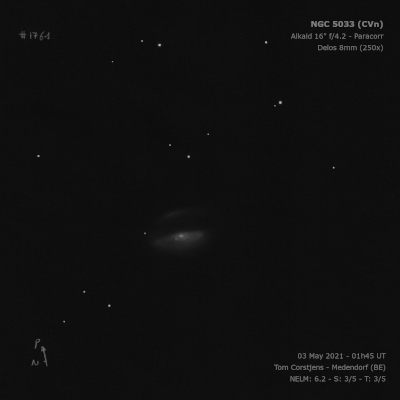
William Herschel discovered NGC 5033 = H I-97 = h1564 on 1 May 1785 (sweep 405) and recorded "vB, pL, E, mbM and the brightness diminishing gradually; the extension not far from the meridian [N-S]."
Bindon Stoney, LdR's assistant on 1 Mar 1851, noted "an appendage [arm] preceding." The arm was mentioned again on 19 Apr 1862: "The patch p[receding] is vF, yet distinctly seen as far as in sketch, but I suspect it joins n end of neb." R.J. Mitchell, observing on 3 May 1858, noted "I also think I see a neb knot sf, in the direction of major axis of neb, but was interrupted by clouds." This "knot" is mostly likely the HII complex NGC 5033:[EKS96] 229, situated 2.4' south of center.
400/500mm - 17.5" fairly bright, fairly large, very elongated 3:1 N-S, small very bright core, stellar nucleus. A mag 15 star is superimposed. Brightest in a group with NGC 5005 40' NW (physical pair).
600/800mm - 24" (5/22/17 and 5/27/17): at 124x and 282x; very bright and large impressive spiral, elongated 5:2 N-S, ~7'x2.8'. Sharply concentrated with a very bright, very elongated core region and an enhanced central axis or bar that increases to a sharp, intense nucleus. There is a strong impression of spiral structure in the halo with slightly brighter and darker regions. A very weak enhancement or HII region is 2.4' due south of center with an hint of an arm segment curving through this patch. An extremely faint, nearly stellar knot (only identified with a DSS image) is 1.3' W of center just northwest of a dim mag 15.7 star in the halo. A brighter mag 14.5 star is superimposed 1.4' NNW of center.
900/1200mm - 48" (4/20/17): at 488x; very bright, very large, elongated 5:2 N-S, some spiral structure is evident. Very well concentrated with an extremely bright, elongated core roughly 1'x0.5'. A low surface brightness spiral arm extends from the core on the north side and hooks sharply south on the west side of the halo. It brightens and appears to end just west of a superimposed mag 14.5 star, situated 1.3' NNW of center. A detached section of this arm was also seen due west of the core, just west of a superimposed mag 15.7 star [0.9' WSW of center].
Although arm structure was not distinguishable on the south side, a brighter knot was visible (at the sharp bend of an arm) 2.4' due S of center. It was roughly 15" in diameter and aligned with the major axis of the core. This HII complex is listed in NED as NGC 5033:[EKS96] 229, from the 1996 "An Atlas of H II Regions in Nearby Seyfert Galaxies" by Evans et al.
Notes by Steve Gottlieb
NGC 4145
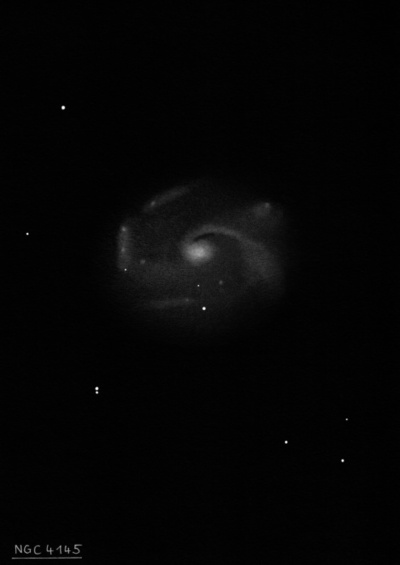
William Herschel discovered NGC 4145 = H I-169 = h1105 on 18 Mar 1787 (sweep 717) and noted "cB, cL." His position is within the halo on the northwest side. On 28 Apr 1827 (sweep 73), John Herschel reported, "pB; vL; dilute; vglbM."
300/350mm - 13.1" (3/17/86): fairly faint, fairly large, very diffuse, weak broad concentration, slightly elongated E-W. Located 9' W of mag 6.9 SAO 44055, a distraction for the low surface brightness galaxy. NGC 4151 lies 30' S.
600/800mm - 24" (5/30/16): at 200x; fairly bright, very large, roughly oval 4:3 ~E-W, 4'x3', contains a large brighter core and a noticeably patchy or irregular halo with a strong impression of spiral structure. Two arms were fairly confident; one extending east of the core on its south side and another extending west of the core on its north side. Otherwise, it seemed like slightly brighter HII patches in the low surface brightness halo were just resolving in the outer halo. Located 9' due west of mag 6.8 HD 105824.
NGC 4145A = UGC 7175 lies 12' SE. It appeared faint to fairly faint, fairly small as often only the 20" slightly elongated core was visible. Sometimes very low surface brightness extensions E-W were seen, increasing the size to ~35"x20", but the full extension of the arms were not detected.
Notes by Steve Gottlieb
NGC 5383
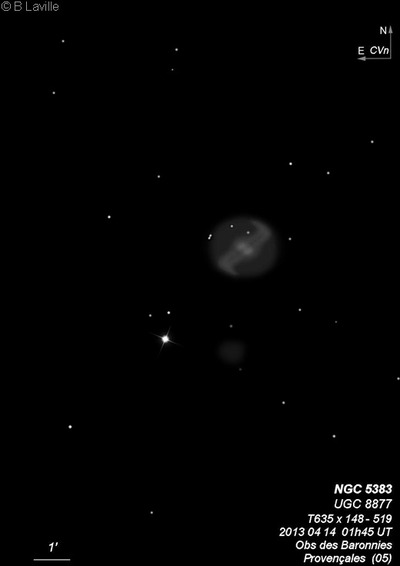
William Herschel discovered NGC 5383 = H I-181 = h1717 on 9 Apr 1787 (sweep 725) and recorded "cB, cL, mbM." JH made the single observation "not vB; R; gbM; 40"." and measured an accurate position.
400/500mm - 17.5" (5/27/95): fairly bright, fairly large, elongated 4:3 NW-SE, 2.5'x2.0'. Contains a prominent bright core about 45"x30" elongated E-W (bar) with the fainter halo tilted 45° with respect to the core. A close pair of mag 14 stars at 8" separation is at the east edge 1.1' from center. Located near the midpoint of mag 10.5 and 12 stars 3' SE and NW.
900/1200mm - 48" (5/9/18): at 375x and 610x; I was impressed by the prominent "Z"-shaped barred spiral appearance! NGC 5383 is strongly concentrated with a very bright oval core, ~0.6' diameter, containing a very small brighter nucleus. The core isn't elongated in the direction of the bar, though, but angles WSW-ENE towards an 8" pair of mag 14 stars 1.1' from center. The central bar is oriented NW-SE and extends ~1.5' x 0.4'. At both ends of the bar are relatively large, bright knots (regions of enhanced star formation), ~18" diameter. A fairly thin, striking "wing" (spiral arm) extends ~0.7' SW from the SE end of the bar, forming a sharp right angle. A less distinct and shorter arm angles NE from the NW end of the bar, completing the "Z" with a "stroke" (core) outline. A low surface brightness, roundish halo, encompasses the striking shape. Two mag 16-16.5 stars are superimposed north of the core. Member of the NGC 5353/5371 Group (LGG 363/361).
UGC 8877, a very low surface brightness dwarf, lies 3' S. At 610x it appeared faint, fairly large, low even surface brightness. This face-on barred spiral didn't display any structure due to an anemic surface brightness. A mag 10.8 star is 2' ENE.
Notes by Steve Gottlieb
NGC 4389
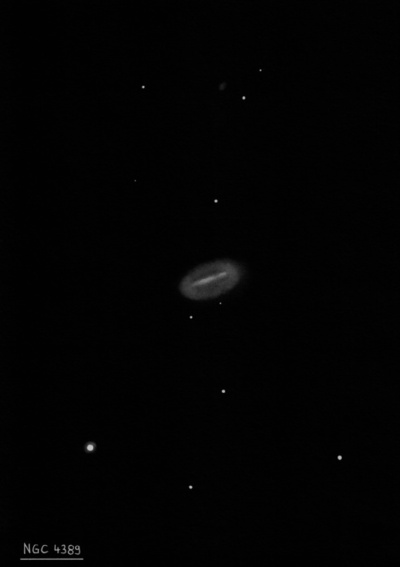
William Herschel discovered NGC 4389 = H II-749 = h1245 on 10 Apr 1788 (sweep 830) and recorded "pB, S, iF." JH made 3 observations, noting on sweep 255 "F; vL; E; vglbM; 2' l, 1.5' br."
On 30 Mar 1856, R.J. Mitchell logged at Birr Castle "pB, E, Nucl, a bright streak runs through the nucleus, growing broader at the preceding end, on either side of this I suspect dark spaces and outside them again faint nebulosity, especially to south side of the nucleus." His sketch was included in LdR's 1861 publication.
300/350mm - 13.1" (3/17/86): moderately bright, moderately large, elongated 5:2 WNW-ESE, brighter along the major axis. A mag 13.5 star is off the SE edge 1.1' from center and a mag 12.5 star lies 2.1' NNW. Similar view on 4/12/86.
Notes by Steve Gottlieb
NGC 5112
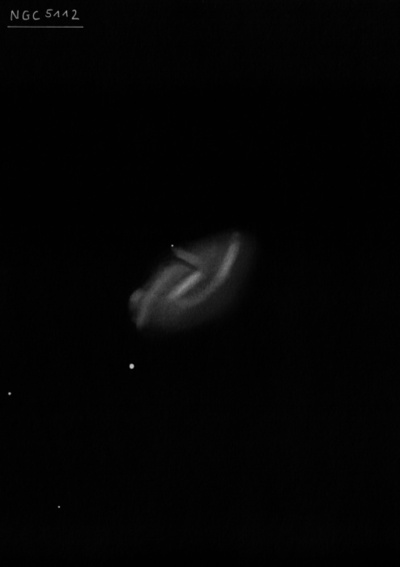
William Herschel discovered NGC 5112 = H II-646 = h1589 on 17 Mar 1787 (sweep 714) and recorded "pB, L, iF; unequally bright, among scattered stars, 3 or 4' dia."
R.J. Mitchell sketched the galaxy in 1856 and 1857 (see LdR's 1861 publication) and noted "sf branch doubtful." On 19 Apr 1857 he added "the bend in p end quite easily seen, the F neby towards the star sf is not nearly so certain."
200/250mm - 8" (5/21/82): diffuse, elongated NW-SE. Located 10' S of a mag 7 star.
400/500mm - 17.5" (6/6/86): this unusual galaxy appears moderately bright, generally elongated NW-SE but the brighter core is offset east of center. A mag 12.5 star is at the southeast edge, 1.1' from the center. Located 9.8' SSE of mag 7.2 SAO 63494. NGC 5107 lies 13' SSW. Member of the NGC 5033 Group (LGG 334).
Notes by Steve Gottlieb
NGC 5394
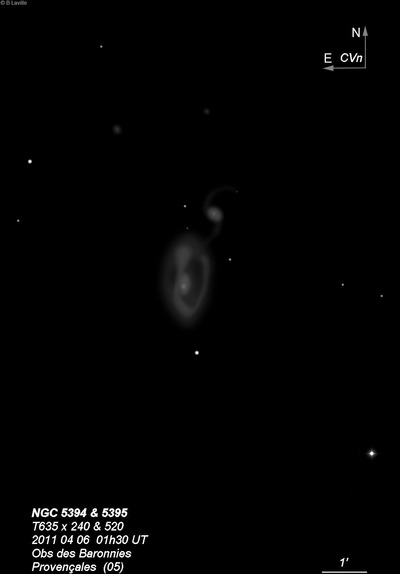
William Herschel discovered NGC 5394 = H I-191 = h1722, along with NGC 5395, on 16 May 1787 (sweep 738) and recorded "Two, that of the south NGC 5395] cB, cL. That to the north [NGC 5394], pB, S. Distance about 1.5'." John Herschel called NGC 5394 the "smaller and np of 2 which nearly join, constituting a double nebula."
400/500mm - 17.5" (6/6/86): this is the fainter northern member of a contact system with brighter NGC 5395 connected at the south tip (2.0' between centers)! Fairly faint, very small, round, brighter core.
900/1200mm - 48" (4/1/11): bright, fairly small, slightly elongated SW-NE, 30"x24", sharply concentrated with a bright, stellar nucleus. A faint arm is visible attached at the SW end that hooks SE towards the NW side of NGC 5995. A fainter arm, which was only visible intermittently, is attached at the NE end and hooks NW.
Notes by Steve Gottlieb
NGC 5410
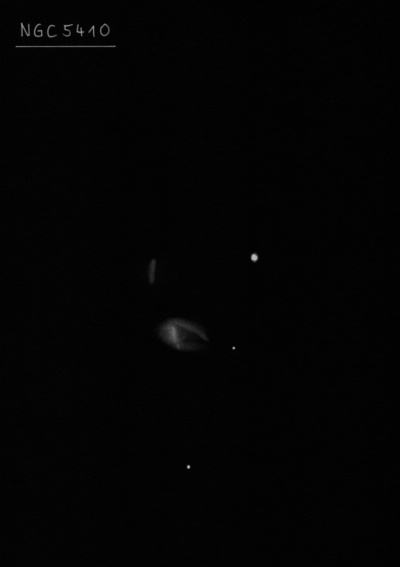
Forms a close pair with UGC 8932 1.2' NE of center. The companion appeared extremely faint, small, very elongated ~4:1 in the direction of NGC 5410, ~0.5'x0.1', very low surface brightness.
William Herschel discovered NGC 5410 = H II-672 = h1729 on 9 Apr 1787 (sweep 725) and logged "pF, pS, bM." JH's single position is 1' west-northwest the center of UGC 8931, though he missed UGC 8932.
400/500mm - 17.5" (7/16/01): faint, fairly small, elongated 3:2 WSW-ENE, 1.0'x0.6', weak concentration. There is a mag 15.5 star just off the western edge. Located 2.2' SE of a mag 12.5 star and 12' NE of mag 8.7 SAO 44838.
Notes by Steve Gottlieb
NGC 5421
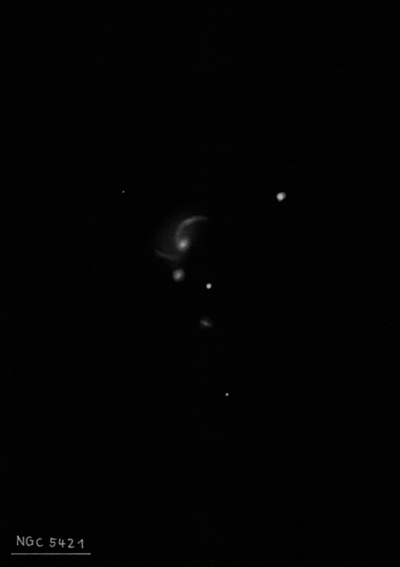
Édouard Stephan discovered NGC 5421 = St XI-22 on 9 Jun 1880. He noted two very faint stars were involved - one of these is mostly likely the southern component of this interacting pair.
400/500mm - 17.5" (7/16/01): fairly faint, fairly small, irregular shape, ~1' diameter. Very unusual appearance like a faint, partially resolved cluster as a couple of faint "stars" are involved. The star is just off the southwest side and a fainter mag 15 star is attached at the southeast end. At moments, a stellar nucleus further confuses the observation. The "star" at the southeast end is VV 120c = PGC 49949, a compact interacting companion.
600/800mm - 24" (7/6/13): this mag 17.1V companion to the NGC 5421 = Arp 111 (double system) was intermittently glimpsed but confirmed at 322x! Situated just 50" S of the center of NGC 5451.
24" (7/6/13): at 282x, this interacting pair (Arp 111) appeared moderately bright, fairly small, elongated 3:2 NNW-SSE but irregular. Contains a very small, bright nucleus. A non-stellar knot companion (VV 120c) appearing like a second bright "nucleus" was visible at the southeast end of the halo. At 322x, VV 120c was easily resolved and appeared faint to fairly faint, very small, round, 10" diameter. A mag 15 star is just off the southwest side. MCG +06-31-046 at mag 17.1V, is just 1' S of the pair and was glimpsed several times for brief moments and confirmed at 322x.
900/1200mm - 48" (5/3/19): this striking interacting pair (Arp 111) consists of a tidally disrupted spiral on the north side and a compact elliptical or lenticular on the south side, separated by 20" between centers. At 613x, the central core region or bar of the spiral appeared bright, fairly small, elongated ~2:1 N-S, ~0.3'x0.15', with a very bright nucleus. A faint spiral arm was easily seen attached at the north end and extending directly west, making an angle of perhaps 110° with the central region. This arm spread out a bit as it faded at its west tip. The southern spiral arm, which extends east, was seen as a dim glow but lacked a distinct edge and merged into the low surface brightness halo on the east side. The southern component (VV 120c) appeared fairly bright, fairly small, round, 0.3' diameter, small bright nucleus.
MCG +06-31-046, a third component of this system, is situated 1' S and appeared faint, fairly small, slightly elongated SW-NE, 20"x15", low even surface brightness. A mag 15 star is 0.5' NNW.
Notes by Steve Gottlieb
NGC 4861
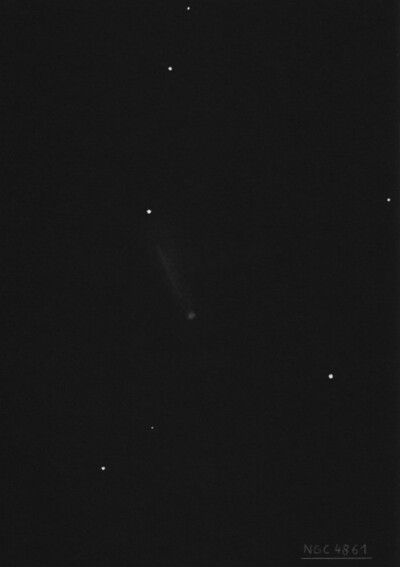
Max Wolf found IC 3961 = W. V-103 in 1903 on a Heidelberg plate. His postion, comments ("pL, pF, elongated in PA 30°) and note ("between two mag 12 stars") matches NGC 4861. Harold Corwin notes that one of the mag 12 stars is the prominent HII region. See NGC 4861.
UGC and CGCG identify the main galaxy as IC 3961 and the bright HII knot as NGC 4861 (Webb Society Quarterly Journal #45, July 1981). Although LdR noted a "bright little knot" at the south end, the HII complex was not given a separate designation in the NGC or IC.
300/350mm - 13.1" (2/23/85): faint, elongated streak SSW-NNE. Stretches between two 12th magnitude "stars". The star at the south end is actually a giant HII region and it appears slightly fuzzy at 166x and clearly nonstellar at 312x.
400/500mm - 17.5" (1/23/93): faint, very elongated SSW-NNE, even low surface brightness. Located between two mag 12 stars at low power. The "star" at the SSW end is slightly nebulous at 166x and appears as a definite nonstellar knot at 332x. UGC and CGCG misidentify this HII region as NGC 4861 (and the galaxy as IC 3961). This is one of the few extragalactic HII regions which responds to OIII filtration.
900/1200mm - 48" (4/7/13): very unusual appearance at 488x as the galaxy is dominated by a very high surface brightness HII region (Mrk 59) at the SSW end, about 15" in diameter and 13th magnitude. The knot appeared extremely bright, roundish, sharp-edged. The main glow of the galaxy is very elongated to the NNE, 3.0'x 0.6', extending just past a mag 13 star near the opposite end. The core is a somewhat brighter, elongated, knotty region, offset closer to the giant HII region. The glow of the galaxy dims as it extends to the star at the opposite end and fades out just beyond. PGC 101479, a compact galaxy, is exactly in line with the major axis of NGC 4861, 3.5' NNE of the mag 12 star. It appeared faint or fairly faint (B = 16.8), round, 12"-15" diameter.
Notes by Steve Gottlieb
NGC 5214
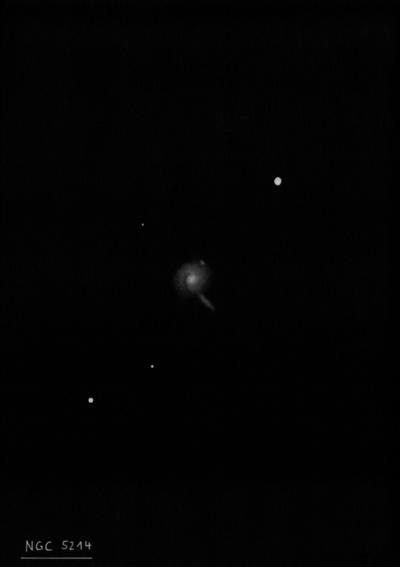
William Herschel discovered NGC 5214 = H III-656 = h1632 on 9 Apr 1787 (sweep 725) and recorded "vF, vS, lbM." JH made the single observation, "vF; R; gbM; 30...40 arcseconds." and measured an accurate position. A faint edge-on companion is off the southwest side.
400/500mm - 17.5" (6/2/00): fairly faint, slightly elongated 4:3 NW-SE, 1.1'x0.8', weak even concentration. Forms the southern vertex of a triangle with a mag 10.5 star 2.7' NW and a mag 10 star 5' NE. Located 18' SE of mag 6.1 SAO 44637.
600/800mm - 24" (6/4/16): at 375x; fairly faint to moderately bright, fairly small, slightly elongated NW-SE, 45"x35", very small bright core. Mag 9.9 SAO 44651 is 5' NE along with a mag 10.7 star 2.8' NW. Located 22' SE of mag 6.1 HD 117710.
Forms a contact pair with NGC 5214A = MCG +07-28-029 just off the southwest edge, 30" between centers. NGC 5214A appeared extremely faint (though not a threshold object) and small, slightly elongated SW-NE, 0.2'x0.1'.
Notes by Steve Gottlieb
NGC 5403
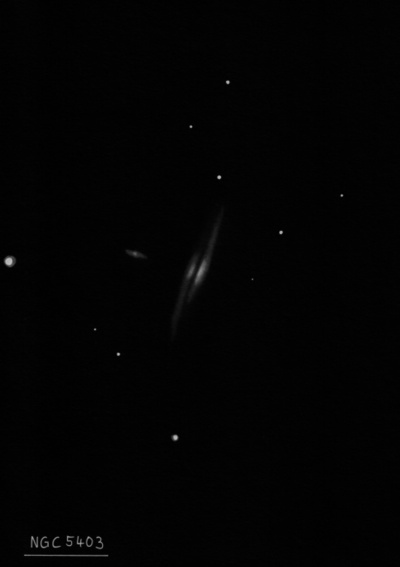
William Herschel discovered NGC 5403 = H III-683 = h1726 on 16 May 1787 (sweep 738) and logged "cF, pL, iF." JH simply logged "eF; pL", and measured an accurate position. He missed the nearby companion.
400/500mm - 17.5" (5/27/95): very faint, moderately large, very elongated 3:1 NW-SE, 2.5'x0.8'. Bulging central region but overall has a low even surface brightness. Forms a close pair with NGC 5403A just 1.6' NE of center. The companion appeared very faint, small, round. Appears as a low surface brightness spot with no concentration.
900/1200mm - 48" (4/7/13): at 488x appeared bright, very large, excellent edge-on 5:1 NW-SE, 3.0'x0.6', broad concentration with a brighter, bulging, elongated core, ~25" diameter. The edge-on disc tapers towards the tips. A subtle equatorial dust lane passes just east of the core region, slicing the galaxy in half, though the section east of the dust is fainter and contains much less of the core.
NGC 5403A = CGCG 191-030 lies 1.7' NE and is angled perpendicular to the major axis of NGC 5403, on line with the core. It appeared fairly bright, fairly small, elongated 2:1 SW-NE, 0.4'x0.2', brighter core.
Notes by Steve Gottlieb
NGC 5096
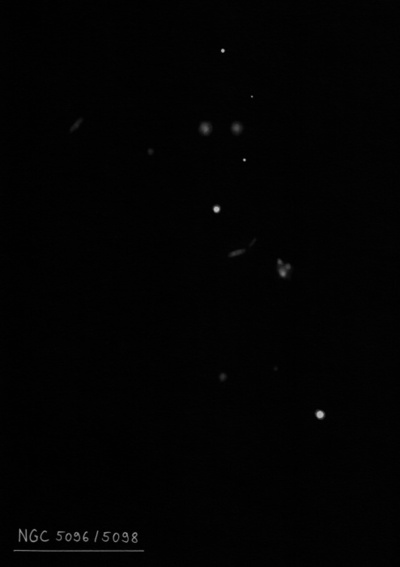
William Herschel discovered NGC 5096 = H III-650 = h1584 on 20 Mar 1787 (sweep 722) and logged "eF, vS." CH's reduction is 22 sec of RA west and 1.4' north of CGCG 189-051 = PGC 46506. Nearby is NGC 5098 to the north, though WH's position is a bit further off from this galaxy (pair). JH made two observations, first calling h1584 (sweep 74) "F; S; R; bM; the sp of 2 [with NGC 5098]. NGC 5096 is a triple, connected system with fainter components attached on the northwest and northeast side.
The MCG misidentifies the western component of the double system NGC 5098 as NGC 5096.
400/500mm - 17.5" (5/23/98): very faint, small, round, 25" diameter. Situated between a mag 10 star 3.1' SSW and a mag 11 star 2.4' NE. In a group with double system NGC 5098 3.5' NNE. An extremely faint companion 1' following was glimpsed several times. NGC 5096, itself, is a very close triple system that was not resolved.
Notes by Steve Gottlieb
NGC 4774
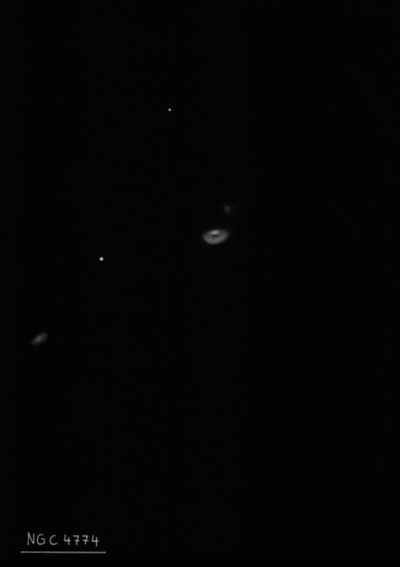
William Herschel discovered NGC 4774 = H III-618 = h1471 on 17 Mar 1787 (sweep 714) and noted "eF, vS." JH logged "eF; S; R: bM. Sky perfectly clear" and measured an accurate position.
400/500mm - 17.5" very faint, small, round, even surface brightness. Appeared fainter than the CGCG mag of 14.6p.
900/1200mm - 48" (4/7/13): at 488x this collisional ring galaxy appeared fairly bright, fairly small, slightly elongated E-W, irregular. It appeared slightly brighter on the north side, which contained a faint stellar nucleus, but I didn't resolve the darker center. Forms a close pair with LEDA 2087677, about 30" N of center. The companion, which is identified as the collider in Madore's collisional ring catalogue, appeared very faint (V = 16.7), very small, round, 9" diameter.
NGC 4774 is nicknamed the "Kidney Bean Galaxy" by Zwicky in his red book (I Zw 45). It was first mentioned as a ring galaxy in 1970 by Cannon, Lloyd, Penston in "Ring galaxies" (The Observatory, Vol. 90, p. 153-154) and it is listed as a collisional ring in Madore, Nelson and Petrillo's 2009 "Atlas and Catalog of Collisional Ring Galaxies" (ApJS, Vol 181, p. 572-604).
Notes by Steve Gottlieb
NGC 4893
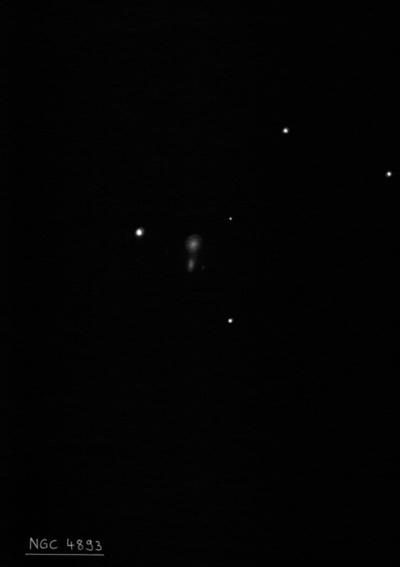
Max Wolf discovered IC 4015 = W. V-136 and IC 4015, the two components of NGC 4893, on a Heidelberg plate taken 21 Mar 1903. He reported both as "D neb, eF, S, iF, N."
400/500mm - 16" LX200 (4/14/07): faint, very small, round, 15"-20" diameter. A mag 13 star lies less than 1' E. This is a contact double system (IC 4015 + 4016 with a separation of 0.35'), though the components were not resolved. Located 11' SW of NGC 4914 and 82' SE of Cor Caroli (Alpha CVn).
600/800mm - 24" (6/4/16): the two close components (IC 4015 and IC 4016) of NGC 4893 were resolved at 322x. The brighter northern component (IC 4015) of NGC 4893 appeared faint to fairly faint, small, round, 15"-18" diameter. The southern member IC 4016) is faint, extremely small, round, 6" diameter. The centers of the two galaxies are separated by just 19". A mag 13.5 star is 44" E and a mag 15.0 star is just under 1' SSW.
Notes by Steve Gottlieb
UGC 8713
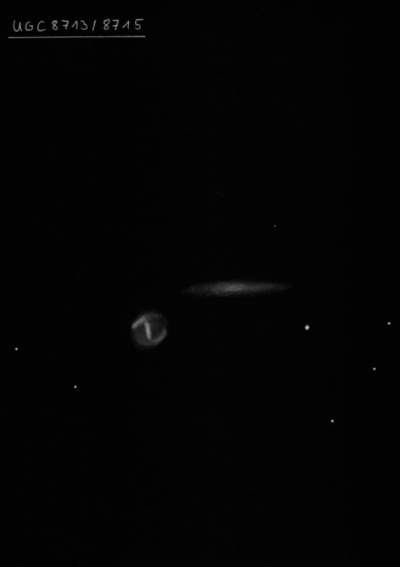
600/800mm - 24" (6/30/19): at 322x; between faint and fairly faint, very elongated 5:1 E-W, 1.0'x0.2', nearly even surface brightness. UGC 8713 forms an interacting pair (VV 317) with UGC 8715 1.4' SE. Located 1.1? SW of mag 4.8 HD 120933 and 6.7' SSW of mag 8.7 HD 120182.
Notes by Steve Gottlieb
HCG 68
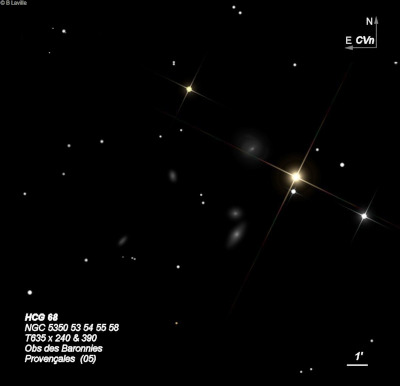
| Type | GALCL [E3] |
| RA | 13:53:40.9 |
| Dec | +40:19:41.0 |
| major_axis | 12.0' |
| mag | 9.5 |
| surface_bright | 99.9 |
HCG 70
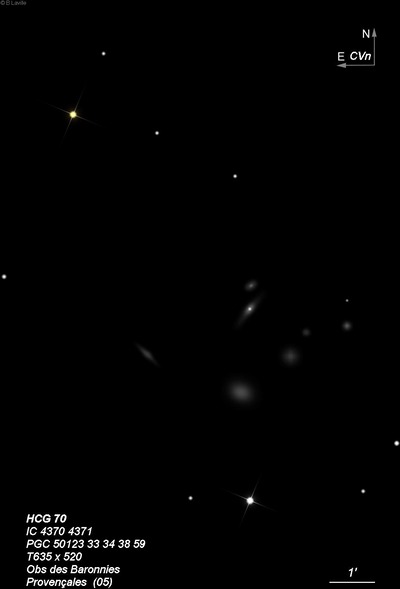
| Type | GALCL [S2] |
| RA | 14:04:13.2 |
| Dec | +33:19:40.0 |
| major_axis | 4.4' |
| mag | 12.1 |
| surface_bright | 99.9 |
IC 883
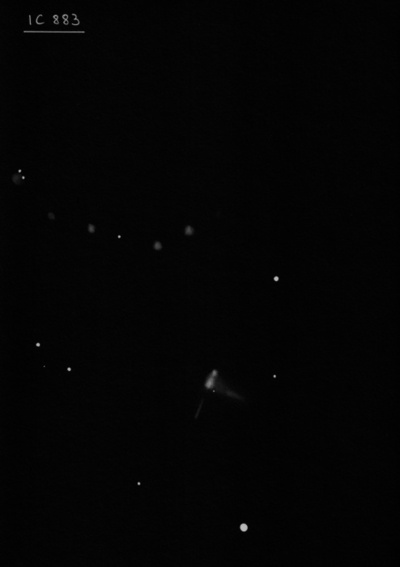
| Type | GX [Im/P] |
| RA | 13:20:35.5 |
| Dec | +34:08:19.0 |
| major_axis | 84.0'' |
| minor_axis | 42.0'' |
| position_angle | 141.0 |
| mag | 13.8 |
| surface_bright | 13.5 |
UGC 7218
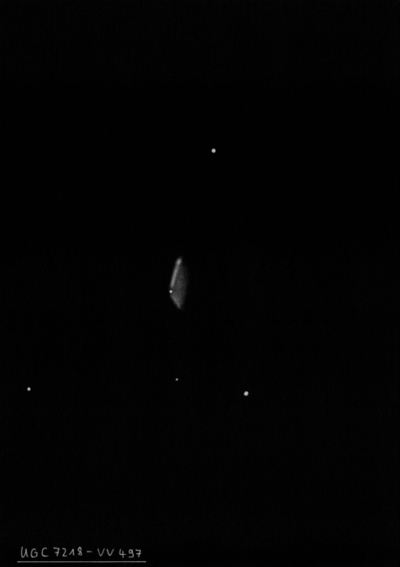
| Type | GX [Irp+] |
| RA | 12:12:56.7 |
| Dec | +52:15:50.0 |
| major_axis | 72.0'' |
| minor_axis | 18.0'' |
| position_angle | 167.0 |
| mag | 14.3 |
| surface_bright | 13.3 |
UGC 8917
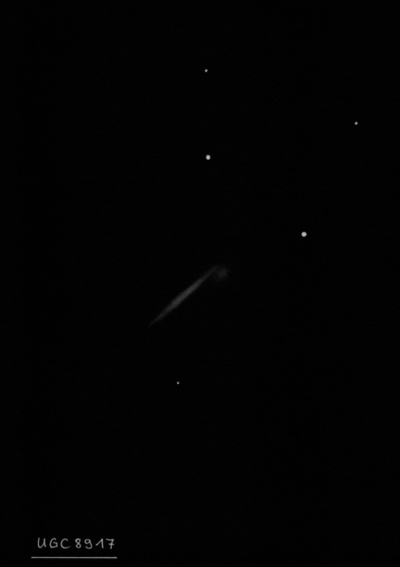
| Type | GX [Sc] |
| RA | 13:59:48.1 |
| Dec | +40:22:54.0 |
| major_axis | 96.0'' |
| minor_axis | 12.0'' |
| position_angle | 123.0 |
| mag | 14.5 |
| surface_bright | 13.6 |
UGC 8960
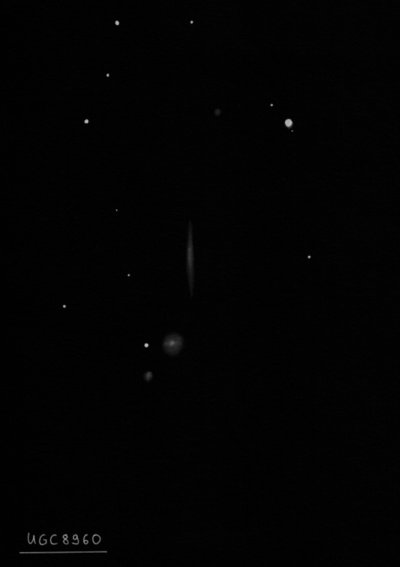
| Type | GX [Sc] |
| RA | 14:02:43.1 |
| Dec | +39:10:06.0 |
| major_axis | 1.7' |
| minor_axis | 12.0'' |
| position_angle | 177.0 |
| mag | 14.5 |
| surface_bright | 14.0 |
